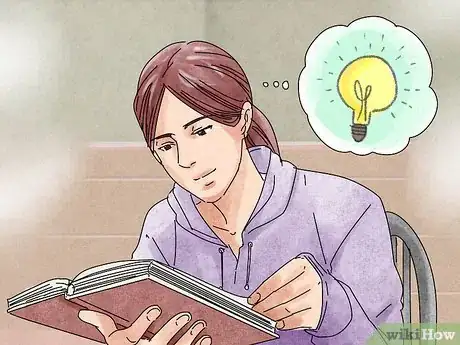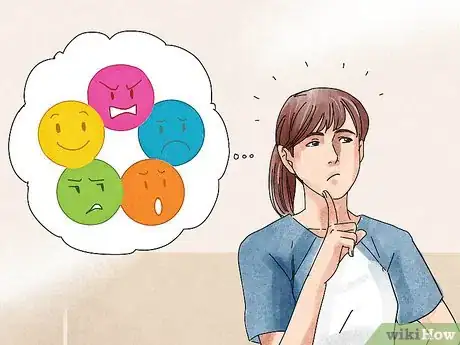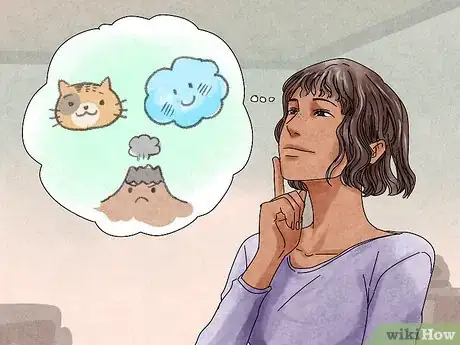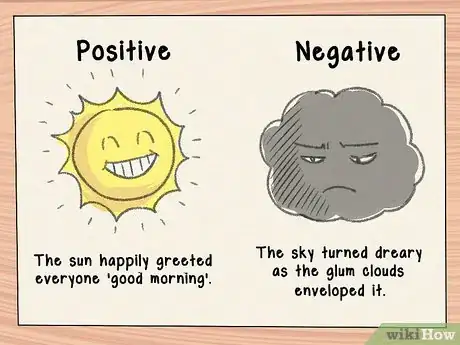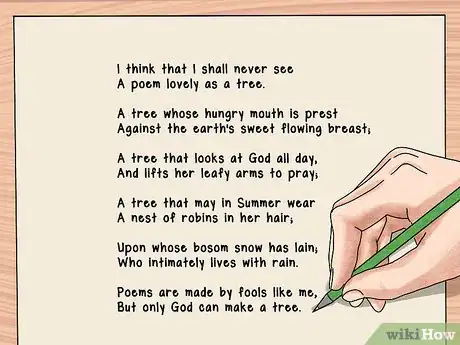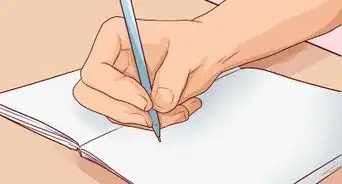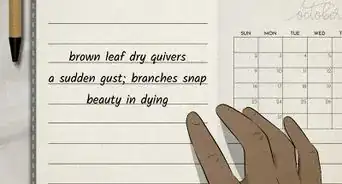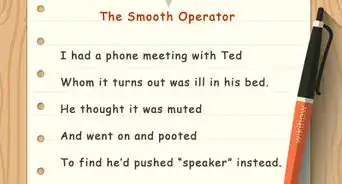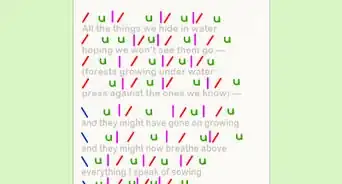This article was co-authored by Michelle Golden, PhD. Michelle Golden is an English teacher in Athens, Georgia. She received her MA in Language Arts Teacher Education in 2008 and received her PhD in English from Georgia State University in 2015.
This article has been viewed 110,716 times.
Personification means using human qualities (thoughts, emotions, actions, etc.) to describe non-human things. This could be anything from a tree, to an animal, or a table. Saying “the sun is smiling,” is attributing human qualities to a non-human object, and is an example of personification. Personification is often used in poetry and can be a good way to evoke strong imaginative imagery.[1]
Steps
Finding Inspiration
-
1Look for inspiration in literature. If you need some inspiration before you get going on the poem, a great place to start is in literature and poetry. Find a poem you like and go through it to identify instances of personification. Looking for examples of personification in a poem will help you learn how exactly personification works and the different ways it can be used to express emotion.
- For example, you could look at William Wordsworth’s poem ‘I Wondered Lonely as a Cloud’.
- In this poem you will read daffodils ‘Tossing their heads in a sprightly dance’.
- There are lots of easy to read personification poems online that you can look at for inspiration.[2]
-
2Think about the emotions you want to express. Once you have found some good examples, think about the way the poems use personification to express emotion. Dancing daffodils in Wordsworth suggest happiness and joy, but how can you use personification to express more negative emotions?[3]Advertisement
-
3Pick some objects to personify. Before you get started on your personification poem, it’s a good idea to spend a little bit of time getting to grips with how personification works. This will help you to ensure that you are completely clear on what it is and how you do it. Start by just writing down a list of around ten objects that you might like to personify in a poem. Some examples might include:[4]
- An animal, such as a cat or a dog.
- A natural phenomenon, such as a cloud or a storm.
- A geographical or geological feature, such as a mountain or a volcano.
Developing Your Ideas
-
1Write down some words that can personify. Once you have written down a list of things that you can personify, now you can write down a list of the ways in which you could describe objects or nonhuman things as people. For this you will need to write down human qualities, actions and characteristics that you find powerful or evocative. This might include:[5]
- Human expressions, such as smiling or frowning.
- Human feelings, such as embarrassment or anger.
- Human actions, such as dancing or running.
-
2Describe the objects as though they were people. When you have your two lists you can try to match up the objects with the words that can personify them. Depending on your lists you may have some odd combinations, but the important thing is just to learn the process of personification. Some possibilities based on the examples above include:[6]
- The cat was smiling at me.
- The angry cloud moved closer.
- The peaks of the mountains danced on the horizon.
-
3Try positive and negative uses of personification. As you get the hang of personification you can think about the different ways you can use it to create an imaginative image or provoke a feeling. Attributing human qualities to nonhuman things often represents a positive or a negative association.[7]
- For example, a smiling cat would normally be a positive friendly image.
- The angry cloud, however, is a more negative and threatening image.
- In this example, the cloud and the description of it as angry, work together to produce an image in your mind.
- Write down a few examples of positive and negative personifications.
Writing Your Poem
-
1Choose your theme. Before you begin writing your personification poem, you need to choose your theme or topic. This could be absolutely anything you like. To get started you could pick one of the images from the two lists you made earlier. For example, the smiling cat, or the angry cloud.
-
2Write a short personification poem. When you have chosen something, try to write a short poem about it. Remember that poems come in all shapes and sizes, and don’t have to rhyme. Don’t be afraid of messing it up, write down what comes into your head and then you can revise and edit it afterwards.
- If you chose the angry cloud, you could write a few lines about watching an approaching storm.
- It could start with a line describing seeing angry clouds rushing towards you.
- Try to write at least four lines about watching a storm that personifies the weather.[8]
- Then pick another of the images you wrote down earlier and write a short poem about that.
-
3Try a longer poem. After you have written a few shorter poems, you’ll be confident enough about personification to write a longer and more complex poem. This could have a longer narrative and involve more developed imaginative imagery. For example, you could extend the poem about the storm to include a section in which the storm passes on and the weather becomes calm again.
- Remember to keep using words that personify nonhuman things.
- In this example you might say that the angry clouds passed, and a bright blue sky grinned down at you.
- You can use words that personify the weather after the storm in a positive way, which contrasts with the negative personifications of the weather during the storm.
-
4Think more deeply about what your poem says. You can continue to develop your writing and your poetry by thinking more deeply about the emotions and experiences you are trying to express. Personification is such as major part of poetry and literature, because we find it easier to relate to something that has human traits.
- Personification can also give deeper meaning to things that appear less meaningful from the outside.
- Remember that we all look at the world through a human perspective, and personification works to creatively bring nonhuman things into that perspective.[9]
Community Q&A
-
QuestionWhat is an example of personification?
 Community AnswerAn example can be "The skirt on the clothesline danced in the wind." In this sentence, the skirt, an inanimate object, is given a human characteristic, the ability to dance.
Community AnswerAn example can be "The skirt on the clothesline danced in the wind." In this sentence, the skirt, an inanimate object, is given a human characteristic, the ability to dance. -
QuestionCan you provide some examples of personification?
 DonaganTop AnswererClick on the source citations below, particularly footnote #3.
DonaganTop AnswererClick on the source citations below, particularly footnote #3. -
QuestionHow do I do an alliteration poem?
 Community AnswerAlliteration poems are those that feature alliteration. Alliteration is the use in close proximity of several words that start with (or prominently feature) the same letter, particularly a consonant. An example is the tongue-twisting nursery rhyme "Peter Piper picked a peck of pickled peppers..."
Community AnswerAlliteration poems are those that feature alliteration. Alliteration is the use in close proximity of several words that start with (or prominently feature) the same letter, particularly a consonant. An example is the tongue-twisting nursery rhyme "Peter Piper picked a peck of pickled peppers..."
References
- ↑ http://literarydevices.net/personification/
- ↑ http://www.poetrysoup.com/poems/personification
- ↑ https://penandthepad.com/sensory-imagery-mean-poetry-1667.html
- ↑ https://examples.yourdictionary.com/humorous-examples-of-personification-in-poetry.html
- ↑ https://examples.yourdictionary.com/humorous-examples-of-personification-in-poetry.html
- ↑ https://penandthepad.com/sensory-imagery-mean-poetry-1667.html
- ↑ http://www.poetry4kids.com/blog/news/personification-poetry-lesson-plan/
- ↑ http://www.poetry4kids.com/blog/news/personification-poetry-lesson-plan/
- ↑ http://literarydevices.net/personification/
